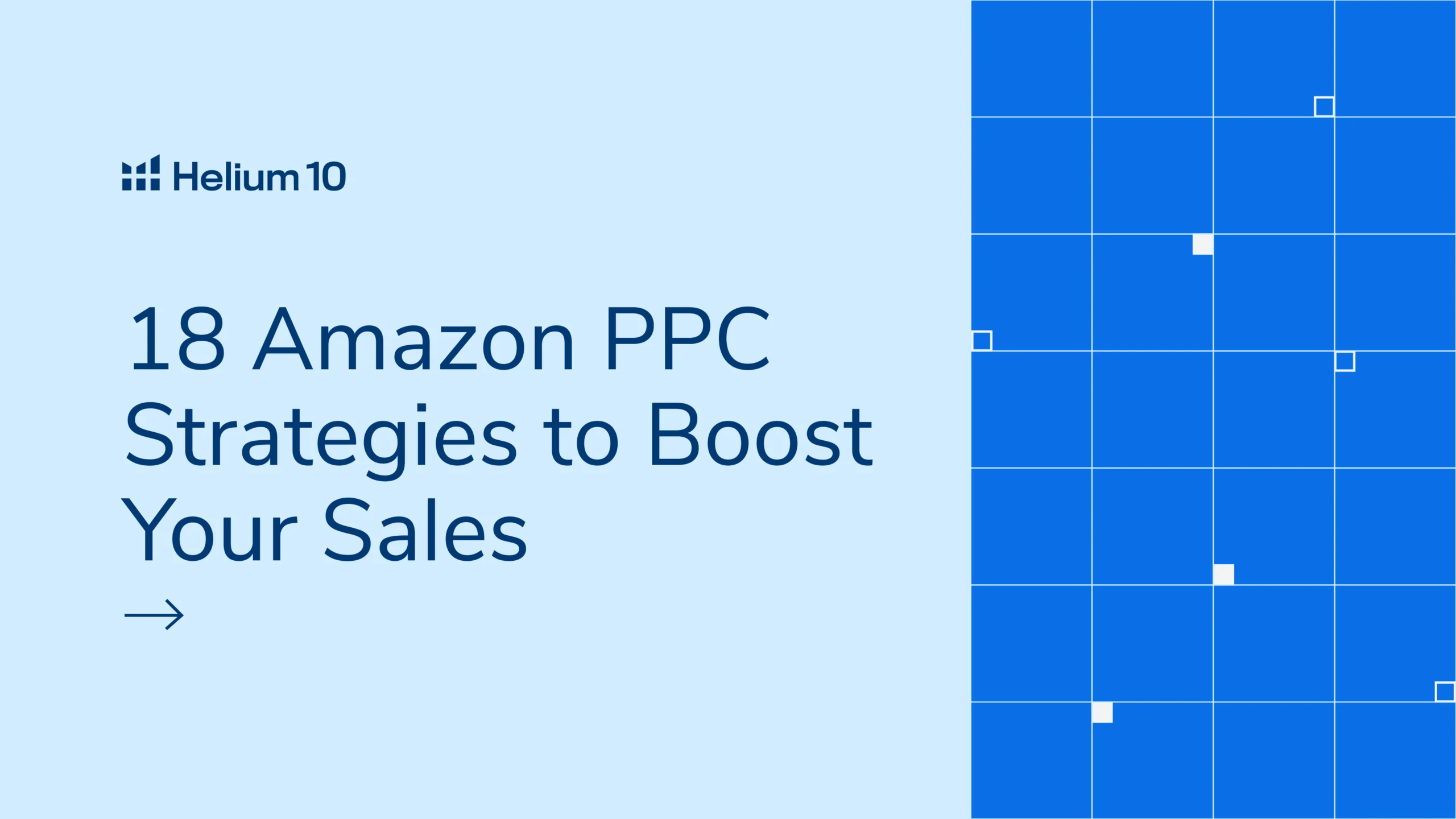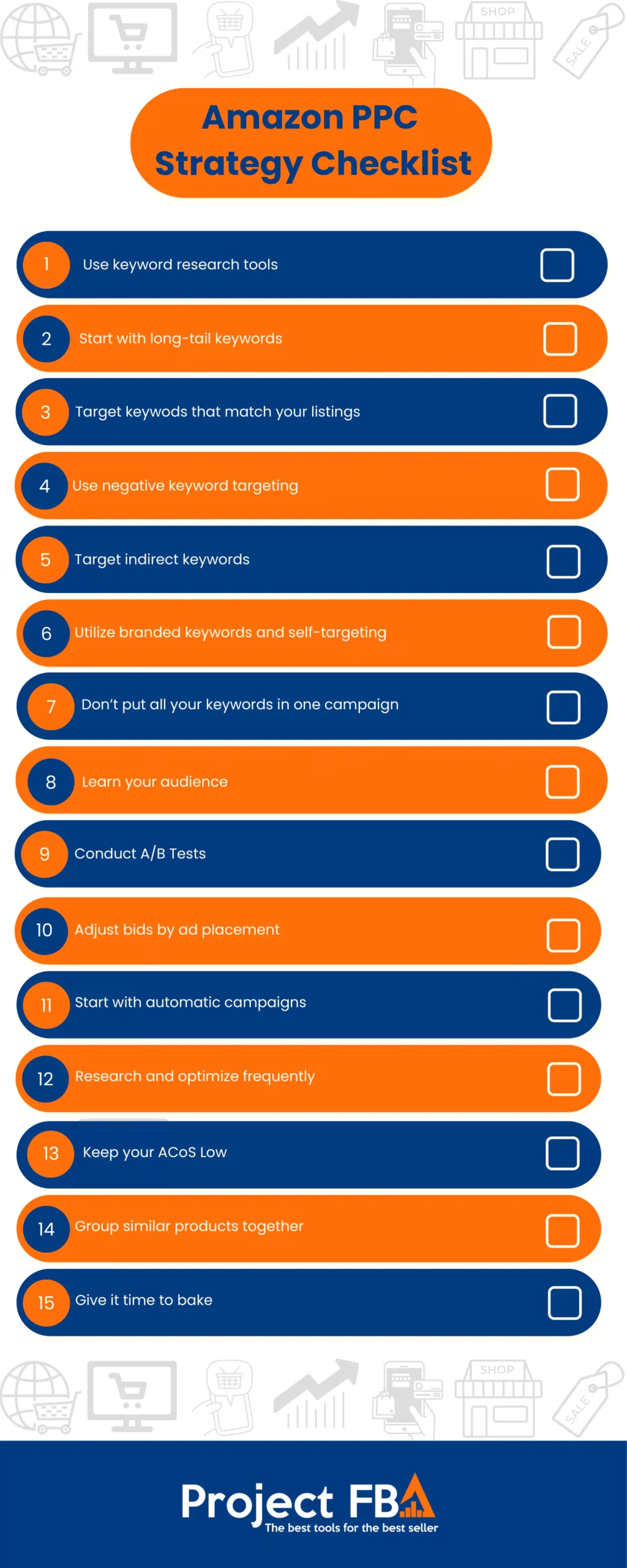
18 Amazon PPC Strategies to Boost Your Sales


Table of Contents
- Amazon’s Key PPC Metrics
- Top 18 Amazon PPC Strategies for Success
- 1. Use Keyword Research Tools
- 2. Start With Long-Tail Keywords
- 3. Target Keywords That Match Your Product Listings
- 4. Use Negative Keyword Targeting
- 5. Target Indirect Keywords
- 6. Defend Your Brand Utilizing Branded Keywords And Self-Targeting
- 7. Don’t Put All Your Keywords In One Campaign
- 8. Learn Your Audience
- 9. Conduct A/B Tests
- 10. Adjust Bids By Ad Placement
- 11. Start With Automatic Campaigns
- 12. …Then Move to Manual Campaigns
- 13. Research and Optimize Frequently
- 14. Keep Your ACoS Low
- 15. Spend Money To Make Money
- 16. Group Similar Products Together
- 17. Try Sponsored Brand Video Ads
- 18. Give It Time To Bake
- How an Advanced Amazon PPC Strategy Can Accelerate Your Business
Amazon pay-per-click (PPC) advertising is an uber-cost-effective way to market your products or brand. With a pay-per-click model, you only infer costs when your audience clicks your ad. To put it plainly — you only pay when you get results. Talk about a smart way to advertise.
One of the best ways to amplify your brand’s presence is to create a comprehensive Amazon PPC strategy from start to finish. It’s not enough to roll out a campaign and hope it’s successful. You’ll want to plan your implementation and monitor your results to bolster your return on investment.
Then, you’ll scale your campaigns and focus on Amazon PPC optimization. This means you further enhance your ads to reach new audiences and capture more attention. With these 18 advanced tips, you can create a robust strategy to boost your sales.
Outclass Your Competitors
Achieve More Results in Less Time
Maximize your results and drive success faster with Helium 10’s full suite of Amazon and Walmart solutions.
Sign Up for Free
Amazon’s Key PPC Metrics
Before you jump into the Amazon PPC world, there are a few metrics you’ll want to understand. These allow you to plan better campaigns and analyze your budget. They will also provide you with measurable benchmarks to determine the success of your campaigns.
- Impressions: Your impressions represent the number of times Amazon users are seeing your ads. This can tell you how well-optimized they are and if you need to adjust your budget constraints.
- Clicks: This is simply the number of actual clicks your ad receives (and the only time you’ll pay for the ad). With this metric, you can compare how attention-grabbing and enticing your ads are to viewers.
- Attributed sales: Attributed sales are the purchases generated from viewers who click on an ad and actually complete the transaction. This lets you pinpoint which ads in your campaign are the most successful at moving customers through the sales funnel.
- Advertising Cost of Sales (ACoS): Your advertising cost of sales is the easiest way to compare ad spend and the revenue you’ve made. To calculate ACoS, you’ll take the cost you’ve spent on a select set of ads and divide it by the revenue generated from them (attributed sales). Then, you’ll multiply the number by 100 to get a percent. This percentage gives you a simple method for comparing the success of various ads and campaigns.
- Return on Ad Spend (RoAS): RoAS is a broader metric used in various online advertising platforms, including Google Ads. It represents the revenue generated for every dollar spent on advertising. The formula for calculating RoAS is dividing the revenue from advertising by advertising spend. The goal is to achieve a RoAS greater than 1, signifying a profitable advertising campaign. Higher RoAS values indicate more efficient use of the advertising budget.
Top 18 Amazon PPC Strategies for Success
Since so many sellers take advantage of Amazon PPC ads, it’s vital to use them with smart strategies. This can help boost the success of your campaign and help you gain visibility over your competition.
1. Use Keyword Research Tools
You may have a firm grasp of the ideal keywords for your products. But, the human brain is no match for algorithm-driven keyword research. Amazon PPC research tools, like Helium 10, allow you to harness countless data points and understand exactly what your customers are searching for. That way you can tailor your listings to meet consumer demands, improving visibility on Amazon and ultimately leading to more sales.
Here’s how you do keyword research with Helium 10:
- Navigate to the Helium 10 dashboard and select the ‘Keyword Research’ tool. Here, you can input your product or niche, and Helium 10 will generate a list of relevant keywords.
- The Magnet tool is particularly useful, drawing in related keywords like a magnet. This feature shows not only the search volume of each keyword but also its ranking, providing insight into the competition and potential profitability of each term.
- The Cerebro tool, another key element of Helium 10’s keyword arsenal, allows you to analyze your competitors’ keyword strategies. By entering your competitor’s ASIN, Cerebro will reveal which keywords they rank for, giving you valuable data to refine your own keyword strategy.
You’ll be able to discover low-competition keywords and will likely discover a few you haven’t even thought of before.
2. Start With Long-Tail Keywords
It may seem counterintuitive to make your keyword list as specific as possible. But using long-tail keywords is one of the best ways to reach your most relevant audiences. A long-tail keyword is a specific search phrase that typically contains three or more words and targets a niche demographic rather than mass audiences.
Compared to single-word or short-tail keywords, long-tail keywords are more likely to convert to sales as they capture late-stage funnel visitors who are closer to a purchasing decision. If customers find that you’re offering the specific thing they’re searching for, they can be more eager to hit the buy button.
As an example, let’s say you sell running shoes. While the basic keyword might be “running shoes,” a long-tail keyword could be “women’s trail running shoes size 7.”
Long-tail keywords also tend to have lower competition and are, therefore, easier for you to rank for. That means you’ll likely see more clicks.
3. Target Keywords That Match Your Product Listings
This may seem obvious, but it’s easy to fall into the trap of using enticing keywords that don’t exactly represent your product. Plus, when your ad’s verbiage aligns with your product listings, customers will feel like they’re seamlessly transitioning between the two. So, try to align common words to create a cohesive feel where your audience knows what to expect.
4. Use Negative Keyword Targeting
Not all impressions are created equally. If your ads show up to audiences that aren’t relevant to your products, they become white noise. To prevent this, you can use negative keyword targeting with automatic campaigns. Negative keyword targeting is a list of search terms for which algorithms will keep your ads from appearing in results. That way, you aren’t wasting impressions on queries that have nothing to do with your products. For example, if you’re selling reading glasses, your negative keywords could include “wine glasses” or “sunglasses.” This avoids unintentionally marketing to shoppers looking for those items.
5. Target Indirect Keywords
An indirect keyword is a search term that is related to the main keyword but does not necessarily include the main keyword itself. They’re a great way to capture a wider audience of customers who may need your product but use a slightly different search query.
Let’s go back to the running shoe example. If the main keyword is “womens trail running shoe,” an indirect keyword could be “trail running gear” or “outdoor sports equipment.”
While indirect keywords may not directly contribute to the search ranking for specific products, they can be instrumental in driving broader visibility and attracting potential customers who may not have been initially searching for your product. You can use your keyword research tools to discover indirect keywords that are still accurate for your product.
6. Defend Your Brand Utilizing Branded Keywords And Self-Targeting
Branded keywords are specific words or phrases that are associated with your brand name and help to establish your online presence. These can include your company name, product name, taglines, and even your slogan.
By utilizing branded keywords in your content and targeting them specifically within search engines, you can defend against competitors who may use similar keywords. This ensures that when someone searches for your brand specifically, they will find you easily without being redirected to a competitor’s website. Using Helium 10 can help you identify popular search terms related to your brand and products to find branded keywords. You should also monitor what words customers are using in your reviews—these could be potential branded keywords.
Additionally, self-targeting involves creating content that is tailored towards promoting and highlighting your own brand. This can include showcasing customer reviews and testimonials, creating engaging social media posts about your products, or writing blog articles about the benefits of using your brand.
Self-targeting not only helps to promote your brand, but it also helps to establish a strong and consistent brand voice. Your brand voice is the tone and personality that you use in all of your content and communications. It reflects your company’s values, mission, and overall image.
7. Don’t Put All Your Keywords In One Campaign
Putting all of your keywords in one campaign can result in your ads getting dinged by the Amazon PPC advertising algorithms. Even though the site allows you to add 1,000 keywords to a campaign, ideally, you want to use less than a tenth of that.
Search engines like Google prioritize ad relevance when determining ad placement, so a single, overstuffed ad may not rank as highly as multiple, more targeted ads. Using tons of keywords also makes campaign performance difficult to analyze. And honestly, it simply lacks personalization.
Different keywords often align with different customer intents. By using individual ad campaigns for different sets of keywords, you can tailor your ad copy to more effectively appeal to each user’s specific search intent. This allows you to bid more strategically on keywords and compare strategies across different campaigns. Plus, it lets you focus on highly relevant keywords with which you’ll likely get more clicks and impressions.
8. Learn Your Audience
As with any marketing strategy, keeping your audience at the forefront of your mind is key to crafting effective PPC campaigns. By identifying your ideal customers, you can create targeted ads that speak directly to their interests, needs, and pain points. But how do you pinpoint who your audience is?
Conducting keyword research and analyzing customer behavior data can help you. Additionally, Researching market basket analysis and brand analysis can provide valuable insights into customer behavior and preferences, aiding in developing more targeted and effective marketing strategies.
- Market Basket Analysis (MBA) is a data mining technique that uncovers associations or patterns among a set of items. It’s often used in retail to identify products that are frequently bought together. For a brand, MBA can help understand the combinations of products that customers often purchase, leading to cross-promotion strategies, effective product placement, or bundling opportunities.
- Brand Analysis, on the other hand, involves evaluating the strength of your brand through different aspects like brand awareness, brand equity, and customer perception. This analysis can help you understand how customers perceive your brand and what values they associate with it. Brand analysis can inform changes in communication strategies and identify strengths to leverage and weaknesses to address, ultimately helping to strengthen customer loyalty.
When optimizing your ads, consider what your audience will likely search for. Learning their habits and priorities can help you use keywords more aligned with their needs. For example, maybe you’re selling organic baby food, and your audience is health-conscious parents. Then, your long-tail keywords can include things important to them, like “healthy baby food pouches” or “all-natural baby snacks.”
9. Conduct A/B Tests
Once you’ve created a solid keyword list and overall strategy, you’ll want to narrow the focus of your campaign even further. A simple way to do this is with A/B testing. This means you’ll create two versions of a similar PPC ad and then roll them out simultaneously to see which performs better. Thanks to metrics like clicks and sales generated, you’ll be able to see which is performing better in real-time. Once you identify the best ad option, you can scale its budget for increased visibility.
10. Adjust Bids By Ad Placement
There are several ways you can plan your advertising spend on Amazon. One is to adjust your bid by ad placement to prioritize where users see your ads. This allows your campaign to automatically spend more to make your ads more visible in search results and product pages.
When you add keywords to your campaigns, you can up your bids to gain an extra boost early on. This means you can set your fixed keyword to a certain amount and adjust it manually as you see results. There’s also an option for dynamic bidding (down only). This setting automatically decreases ad bid amounts when sales are unlikely, like in irrelevant search results. However, you can also opt for dynamic bidding (up and down). This allows you to be competitive and bid more for ad placement where sale conditions are favorable for your product. Like down-only bidding, it decreases bid amounts when conversion isn’t probable.
11. Start With Automatic Campaigns
When you’re just starting with Amazon PPC ads, it’s best to rely on campaign automation. This lets you get to know the platform and focus on your strategy. The algorithms generate your keywords and automatically target your audience. Then, you can use this as a base strategy to grow and optimize your campaign as you learn to navigate the data.
12. …Then Move to Manual Campaigns
Once you have a firm grasp of the inner workings of Amazon advertising, you can shift your campaigns to manual ones. Using a combination of Amazon PPC strategies, you can fine-tune them to your objectives and integrate more keywords. You can also pinpoint your bidding strategy and take advantage of trends and market insights.
13. Research and Optimize Frequently
The key to running successful campaigns is ongoing research and optimization. This means staying on top of your data as well as analyzing potential strategies for your products. Using an Amazon PPC manager, you can automate this monitoring and gather intuitive recommendations. Platforms like Helium 10 even allow you to gather ad data and optimize campaigns in the same dashboard as other selling tools.
14. Keep Your ACoS Low
One of the perks of PPC ads is the ability to keep your Advertising Cost of Sales (ACoS) low, giving you the best crack at maximized profits. This means having an efficient keyword strategy, including long-tail and negative ones. You should also take advantage of optimal bid settings to maximize spending and eliminate ineffective ad placements.
15. Spend Money To Make Money
In a competitive marketplace, taking advantage of opportunities is essential. That’s why you have to use higher budgets strategically when you invest in your ads. Your ads can benefit from higher bids during peak conversion windows, whether it be seasonally or throughout the week. For example, if you’re selling candy, plan to invest a little more leading up to major holidays. If you’re selling recreation equipment, spend more to capture shoppers prepping for a long weekend. Regarding daily cycles, research the hottest times in your industry and shift your hourly-based bidding strategy accordingly.
16. Group Similar Products Together
If you have a large or diverse inventory of products, grouping very similar items can organize your campaigns. Maybe you’re selling the same makeup in various shades or one brand of bikes in different sizes. Gather these into one ad group since they will have the same keywords and objectives.
17. Try Sponsored Brand Video Ads
Sponsored brand video ads allow you to tell a deeper story than traditional ads. These can be an excellent investment for demonstrating a product and creating buzz about your brand. Video ads can also capture the attention of browsers in search results. Just be sure you’re ready to create your own video ad or perhaps enlist the help of a pro. Amazon also has an option where you can use their services to create a brand video advertisement. It’s a simple slideshow style, but it’s not bad for a zero-cost production.
18. Give It Time To Bake
Keep in mind that not all campaigns see instant success. So, don’t be tempted to abandon your strategy or make drastic changes. Luckily, the PPC model is relatively low-risk, so you can be confident in letting it run to collect some data. Then, fine-tune it until you find the right mix of Amazon PPC optimization strategies.
How an Advanced Amazon PPC Strategy Can Accelerate Your Business
As an Amazon seller, taking advantage of every tool at your disposal can lead you to success. This means crafting a well-rounded and robust PPC ad strategy. By taking a multi-faceted approach, you’ll be able to take advantage of all the cost-effective perks the advertising model offers. That puts you in the best position to accelerate your growth and experience long-term success. When learning how to optimize your strategy, use Helium 10’s powerful tools to have top-notch technology to guide your journey.
Frequently Asked Questions
Achieve More Results in Less Time
Accelerate the Growth of Your Business, Brand or Agency
Maximize your results and drive success faster with Helium 10’s full suite of Amazon and Walmart solutions.
